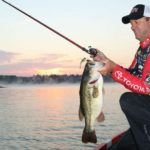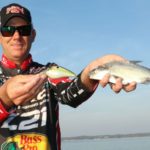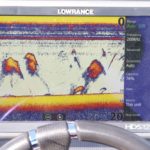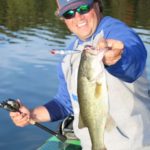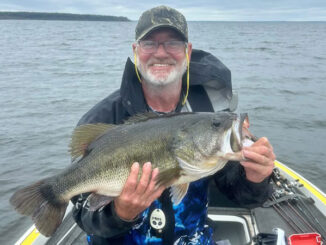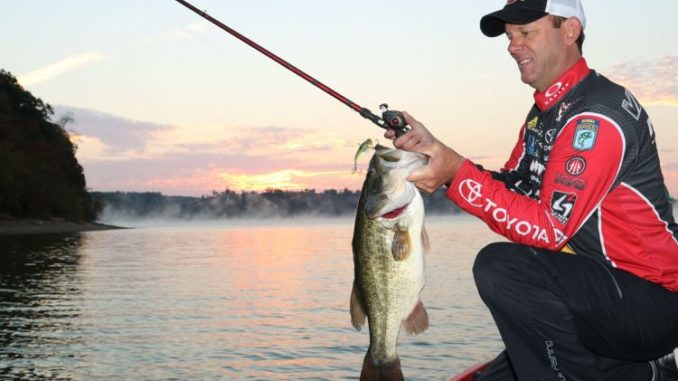
Pro tips for targeting bass this fall
Bass are not terribly complicated creatures to begin with — and in the fall of the year, they become even easier to figure out.
Just find the bait schools.
With winter’s leanness right around the corner, bass know that autumn is gorge time, so look for largemouths to actively roam bait-congregation areas and feed nearly round the clock.
Peak times and ideal scenarios definitely narrow your search; and that’s why Bassmaster Elite pro Jason Christie follows the wisdom of selecting a sensible starting point, but leaving plenty of room for flexibility. He’s always hoping for that daylight bite, but as his day progresses he bases his movements on one simple principle: If you’re not around the bait, you’re not around the fish.
“This is where your electronics can play a key roll because those bait schools will move around during the day to find the right depth where they feel comfortable,” Christie said.
Unquestionably, the most important factor in the temperature game is sunlight. Fall can find bass gorging throughout the day, but sunup and sundown can offer some of your wildest action as the low light conditions find bass feeding with reckless abandon.
In early fall, especially when warmth lingers, the daybreak period spurs feeding as the first rays of light enable them to spot their prey. Conversely, approaching nightfall motivates them to gobble all they can before going to bed.
As fall marches onward and nights become progressively cooler, bait schools and bass will show greater activity in the afternoons. After several hours of daylight, the water temperature will rise to a level sufficient to stimulate the lake’s residents, so make sure you’re hitting your prime areas during those times.
Similarly, consider how tree lines, covered docks, etc. cast shadows on part of the creek or cove. The dark side (not a Star Wars reference) will slow the day’s warmup, so factor this into your game plan.
Weather’s also a key consideration this time of year and the key word is “front,” as in fall cold front. A couple days prior to the weather change, fish will sense the forthcoming temperature decline and the ensuing rise in atmospheric pressure and respond with an absolutely insane feeding flurry.
Once the front passes and those bite-killing “bluebird” conditions overtake the backside, you can expect a stubborn bout of lockjaw for a day or two. Fish have to eat and some may nibble here and there, but post-frontal conditions definitely put the brakes on this deal.
But don’t despair; the show will soon resume — usually by the second day after a front. Once the barometer starts to ease back into comfy zone, the fish will feed like they’re trying to make up for lost time.
Productive patterns
Fall anglers do well with several tried-and-true tactics designed to imitate open-water baitfish activity, but it’s always wise to keep several tools in your box. To this point, FLW pro Nick Lebrun often employs a crafty technique that goes right to the cover the baitfish often use.
“I would recommend focusing on vegetation to find the shad that are shallow,” Lebrun said. “Thick hydrilla is always key, but a lot of times thick lily pads are often overlooked. Most of the time it’s a visual thing — you will see the shad circulating in and out of the grass and pads, and if you’re lucky you may find largemouth actively feeding around these areas.”
In sparse hydrilla, Lebrun will throw a small squarebill crankbait, such as a Black Label Balsa Ricochet Mini or a 3/8-ounce V&M Lighting Blade (shad colors). When he’s fishing thick pads, his presentation depends on the fish’s activity level.
“If they are active I will cast several different types of frogs, such as a V&M Bayou Bullfrog or a hollow body Spro frog. If a front has blown through and you have a north wind, sometimes the pad bite will be tough and then I like to flip a Texas rig to trigger the fish. For this presentation, I’ll use a V&M Flat Wild or JBug paired with ½- to ¾-ounce Elite Tungsten weight.”
Opting for the more traditional route, FLW Tour pro James Watson prefers topwater presentations, as they allow him to cover water and generate memorable strikes. He likes diversity, but follows this rule of thumb: A more subtle buzz toad for calm days and noisier baits like a Whopper Plopper.
During his fall outings, Watson typically targets shallow shoreline cover — laydowns, stumps, etc. During a given day, the fish may show preference for a certain depth, but he remains ever alert for those random schoolings that carry day-making potential.
Elsewhere, bridges spanning the creeks where bass go to hunt shad create distinct funneling points where bass leverage the concentrated flow and ambush points to gobble hapless baitfish. FLW Tour pro Casey Martin’s fond of Rat-L-Traps and he won’t hesitate to go to a hefty ¾- or 1-ounce model when big bait abounds.
Spin to win
Along with his topwater tools, Watson keeps a Luck E Strike Jimmy Houston Legend spinnerbait on his deck for windy days, which minimize the appeal of his topwaters. He’s fond of waking the spinnerbait just below the surface, but a variety of retrieve speeds and depths will tempt bass with a big, flashy display that looks, sounds and vibrates like a cluster of baitfish.
Elite pro Mark Menendez says one of his favorite ways to catch fall bass is mimicking a shad frenzy by burning a spinnerbait. Double willow leaf blades are a must for this pedal-to-the-metal presentation.
“Anytime I can make a fish do what I want, instead of me doing what he wants, I feel like I’m in control,” Menendez said. “I like the Strike King Scorcher because it has a narrow head with a flat spot on the bottom, which is important for keeping the bait high in the water column at high speed.”
Size matters
Noting the fact that fall bass often zone in on a particular forage profile, Toledo Bend guide Darold Gleason said: “I pay closer attention to matching bait size in the fall than I do any other time of the year. Size is the deal. Find a bait that will match the size and reach the desired depth and you’ll have magic.
“I do this with both crankbaits and topwaters. For example a large walking bait (6th Sense Dogma) for places with bigger shad and a smaller Dogma for smaller shad.”
Some of this comes down to life cycle stages and the relative size of baitfish, while it may also be a function of the different shad species — the smaller threadfin and the much larger gizzard shad. To this point, Elite pro Kevin VanDam knows that crankbaits do a dandy job of impersonating both, but while a Strike King 6XD will mimic threadfins, he’s going to need a bigger profile like a Strike King 10XD to fool a bass into thinking he’s cornered a gizzard shad.
Your Alabama rigs, which allow you to greatly vary the size of teaser and target baits, definitely have their place in the fall frenzy, but if you want that cluster look without the bulky package, LIVETARGET’s Baitball Series offers topwater walkers, poppers, jerkbaits and crankbaits adorned with ultra-realistic baitfish images. The company’s Yearling lineup adds another dimension with lures sporting juvenile baitfish images.
Another way to alter the size of your presentation does not require retying — just add feathered trebles. Enhancing your walker, popper or jerkbait with “dressed” hooks not only increases length, but it bolsters the bait’s performance with lifelike display. The feathers contract and expend during movement to create an enticing appearance that may push a hesitant fish over the edge.
Follow up till they fill up
Your wingman, your bro, your “got-yer-back” best bud — we all need someone we can count on to help us out when we stumble or fall short. Same goes with fall presentations.
With the exception of those tough post-frontal days, most of your fishing hours will see fish committed to whatever they attack. Occasionally, however, you may find bass rolling, boiling and simply missing walking, popping or waking baits. Pausing a topwater or subsurface hard bait will often earn you a follow-up bite; but during the fall feeding frenzies, attention spans run short and bass don’t dally.
Rather than burn daylight trying to coax a fish that has probably already turned its attention from topside bites, Elite pro Greg Hackney believes a better strategy involves sending in a soft plastic twitchbait like the Strike King Caffeine Shad he uses to follow up the Strike King Sexy Dog walker he prefers.
Other productive subsurface follow ups include swimbaits or soft plastic stick baits. Weighted wide gap hooks like Mustad’s 38101W UltraPoint KVD Grip-Pin will get your baits down into the water column; but if you want more motion for an enticingly realistic look, use an articulated lead head like the Mustad Fastach Worm Weight, which includes an interchangeable attachement point for adding your hook of choice.
Try swimming, darting, yo-yoing and dead sticking looks to see what triggers those follow-up bites. Sometimes, they want aggressive looks; other times, it’s the subtle flutter and fall of a wounded shad they seem to like. Whatever the case, this time of year is all about the bait; make ‘em think they’ve found a meal and you’ll tighten that line.
